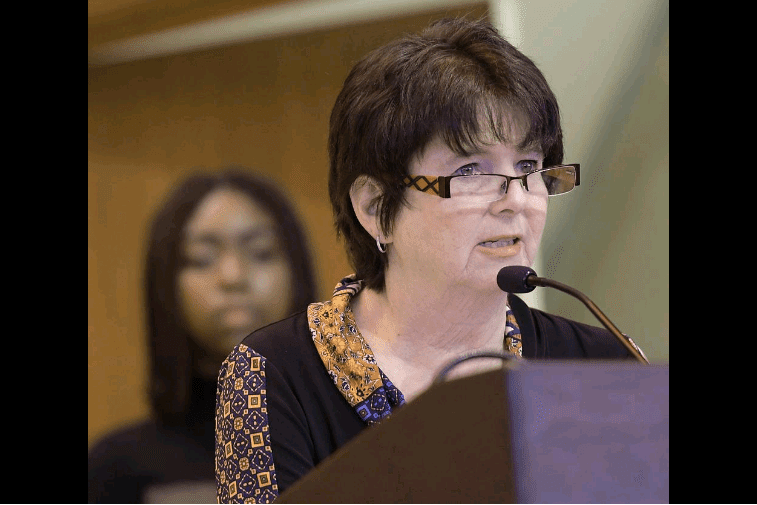
October 10, 2018
An outlier in the state, Worcester schools look to reduce recent spike in emergency removals
By Scott O’Connell, Telegram & Gazette Staff
October 5, 2018
WORCESTER – As the Worcester schools begin a new campaign to lower their suspension rates, a new report shows the district is an outlier in the state for its use of another mechanism for removing students from school.
According to “Unfinished Business: Assessing Our Progress on School Discipline Under Massachusetts Chapter 222” published last month by the Lawyers’ Committee for Civil Rights and Economic Justice, Worcester accounted for almost 60 percent of all “emergency removal” procedures carried out at schools across the state two years ago. Emergency removals allow a school to effectively suspend for two days a student who has committed some offense and is deemed a danger or disruptive presence in his or her classroom and for whom there is no alternative in-school placement.
While the Chapter 222 law enacted in the state in 2014 intended to restrain schools’ use of out-of-school suspensions to discipline students, “Unfinished Business” notes the use of emergency removals subsequently increased since then, led by Worcester, whose 4.6 percent emergency removal rate was triple the rate of the next highest noncharter district in 2016-17.
Robert Pezzella, Worcester’s school safety director, said that discrepancy was likely a misunderstanding by principals of the intended use of emergency removals, and that in 2017-18, for which the state has not yet released school discipline data, the district’s emergency removals declined. He also pointed out the school department, in an effort to meet a goal in the district’s new long-term strategic plan to reduce student suspensions by one-third over the next five years, has identified limiting the use of emergency removals as a “major priority.”
But at the same time, Mr. Pezzella said the superintendent has consistently communicated to principals that school safety should be paramount, and that they can and should use emergency removals when needed and appropriate.
Emergency removals by the numbers
While Mr. Pezzella acknowledged school safety offices like his have been “taking our lumps” in recent years from advocates seeking a reduction in the use of punitive school discipline, it wasn’t that long ago that Worcester and many other districts were suspending students from school at much higher rates. In 2013, for instance, 10.5 percent of discipline cases in Worcester resulted in an out-of-school suspension – a rate that has since dropped to 4.6 percent in the wake of Chapter 222, which established new guidelines meant to steer schools toward using more in-school disciplinary methods.
But that law also resulted in the state propping up emergency removals for cases where principals have no viable options for keeping a dangerous or disruptive student in school. At first, very few districts used them, according to state records: in 2014-15, for example, hardly any systems employed it all – the state average was rounded down to 0 – while Worcester only had a 0.5 percent usage rate.
“Since being introduced … the use of emergency removal has risen dramatically, from just 460 instances in 2014-15 to over 2,600 in 2016-17,” the report says. “This is cause for serious concern, as these emergency removals are intended for unusual circumstances, not as a general workaround for vital due-process protections.”Two years later, in 2016-17, emergency removals were still rarely used, and some of the state’s largest districts, including Springfield, continued to post 0 percent usage rates. But the authors of “Unfinished Business” noticed the overall frequency of emergency removals had quickly crept upwards.
The study further says, for example, that just over half of those emergency removals in 2016-17 were used for an “incident of minor misbehavior,” which would seem to go against the intent of the practice.
The report also found that emergency removals were disproportionately affecting minority student groups like English-language learners and students with special needs. In 2016-17, for instance, Worcester’s emergency removal rate for disabled students and Latino students was 9 percent and 5.8 percent, respectively, compared to just 2.7 percent for white students, according to state records.
Why Worcester?
The study’s authors, meanwhile, were puzzled by why Worcester was using emergency removals so much more frequently than comparable districts, opining in the report that discrepancy could either be a result of the district simply turning to that option more, or more accurately reporting it than other systems.
“There’s probably a little bit of both of these scenarios” at play, said Joanna Taylor, who co-authored the report. Part of the problem in finding a concrete answer, she added, is that it’s difficult to ascertain the “internal politics in each district” that might contribute to one using emergency removals more than another.
Multiple requests this past week to speak with representatives of the Boston and Springfield school systems about their relatively low use of emergency removals were not answered by the Telegram’s deadline Friday.
Thomas Conroy, a professor in the urban studies department at Worcester State University who has been conducting research into school discipline trends, including emergency removals, for the past five years, surmised Worcester’s outlier status had more to do with the district’s interpretation of the law.
“According to the school system, they were following the policy as they understood it,” he said, adding “it was a complete misread” of the law.
Mr. Pezzella acknowledged “the message from (the state’s education department) was somewhat misconstrued” by administrators in Worcester. “I think it was a misunderstanding of the intent of emergency removals.”
Superintendent Maureen Binienda, who was principal at South High Community School when the Chapter 222 changes went into effect, said even she didn’t realize the ramifications of the emergency removal provision at the time; she and other administrators believed they were not categorized as suspensions.
Worcester’s overall number of emergency removals has since dropped from 1,913 in 2016-17 to 844 last school year, according to Mr. Pezzella, as principals became more selective in their use of them. Even with the decline, Worcester’s usage rate would still be higher than comparable districts’ from the year before, however – a continued discrepancy that Ms. Binienda said her administration wants to figure out.
“I think that’s why we’re examining it,” she said. “That’s our baseline – we’ll look to see how we can improve it.”
But she and Mr. Pezzella also defended Worcester’s employment of the practice in general.
“It can be an effective tool,” Ms. Binienda said. “We’re just being very conscious not to use it when it’s not necessary.”
“Of all the ones I’ve seen, every one of them has been considered appropriate,” Mr. Pezzella said. “All it takes is one student to create upheaval in the classroom.”
Following the law?
Nicole Cardamone, a staff attorney at Community Legal Aid in Worcester who has represented families in many local school discipline cases, contests the idea that all emergency removals have been warranted, however.
“We’re seeing cases where it’s questionable if the high standards (of the law) are being met,” she said. She cited one case, for example, where a young student with disabilities was taken out of school via emergency removal for “being disrespectful.”
Part of the problem is that emergency removals, unlike out-of-school suspensions, do not have to be preceded by any sort of hearing; all the law says is that schools must contact the student’s parents and provide written notice of the removal, and offer the family a hearing before the two-day suspension is over.
“They’re so quick, by the time these folks come to us, they’re already through the second day,” Ms. Cardamone said, adding her office’s focus in those cases is mostly on helping those families understand their rights in case their child is the subject of an emergency removal again in the future.
But while they may be brief, the effects of emergency removals are not any different from home suspensions, which studies have shown can have a negative effect not only on students’ academic success but also their likelihood for continuing to exhibit risky behaviors, according to experts.
“No matter how you slice it, it’s time out of class,” said Ms. Taylor, who added the particular danger with emergency removals is school administrators “thinking they’re not actually suspensions.”
Making improvements
Significantly reducing the number of students who are taken out of school, either by suspension or emergency removal, isn’t as easy as it sounds, however, according to Worcester school officials.
Particularly in the lower grades, where emergency removals have been most commonly used, “the last thing we want to do with any student at that age is remove them from school,” Mr. Pezzella said. But the reality, he added, is that “we’re seeing a lot of young students who are not prepared to come to school because of an array of issues that are affecting their ability to learn in a classroom.”
If those students act out in class, posing danger to their fellow students and teachers, the school has to put them somewhere else, he said, but the district doesn’t have many options currently. The system has two respite programs for students, with another one in the works specifically for younger children, but there aren’t enough resources to pay for the staff necessary to deal with every student who needs to be removed from his or her classroom, according to Mr. Pezzella.
But the school department is looking for solutions; over the summer, Ms. Binienda formed a new committee tasked with finding ways to reduce the number of suspensions and emergency removals in the district. Its goal, as outlined in the new strategic plan, is to reduce the percentage of students suspended for nondrug-related, nonviolent and noncriminal offenses from the current 4.8 to 3.2 by 2023.
“It’s not as easy a fix as people think,” Ms. Binienda said. “It’s going to require new programs we’ll have to develop.”
At this stage of the process, meanwhile, “we’re really doing a deep dive into the data,” she said. “In order to change things, we need to know what’s working and what isn’t.”
Looking to help, but expecting changes
Many people and organizations in the city will be watching their efforts closely. Mary Jo Marion, executive director of the Latino Education Institute at Worcester State University, said anxieties about school discipline have been on the rise in recent years in Worcester.
“The number of questions have increased, the level of concern has increased,” she said, adding the amount of inquiries from parents led her organization to put together an informational session on the topic for families for the first time this past year. “They’re not understanding how it is they send their student to school, and then they get sent back.”
Of particular concern to her institute, Ms. Marion said, is the continued inequity of the distribution of discipline in the schools; even as the number of suspensions has gone down, for instance, the percentage of minority and disabled students receiving that punishment has consistently been higher than that of their white and abled peers in Worcester. While she was encouraged by the district’s renewed focus on reforming school discipline in the strategic plan, she said, “I would have liked to have seen a commitment to racial equity” be an identified part of that effort.
“What makes Worcester unique is that it has a very supportive community” willing to help the schools reach those goals, however, Mr. Conroy said, noting he and his colleagues have extended their own assistance in the form of a predictive model that could help the schools identify and design interventions for students who are likely to get into trouble.
At this point, however, Ms. Binienda said she’s taking a more in-house approach to tackling the district’s problems.
“Right now we’re trying to talk about what internal changes we can make ourselves,” she said, adding if their findings suggest they’ll need some outside help, the schools will seek it.
www.telegram.com/news/20181005/outlier-in-state-worcester-schools-look-to-reduce-recent-spike-in-emergency-removals
Scott O’Connell can be reached at Scott.O’Connell@telegram.com. Follow him on Twitter @ScottOConnellTG

















































